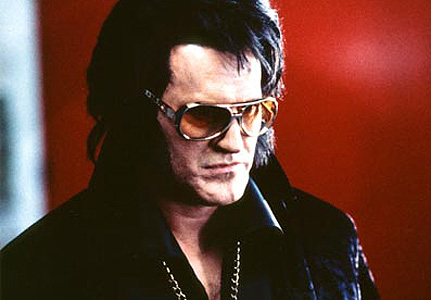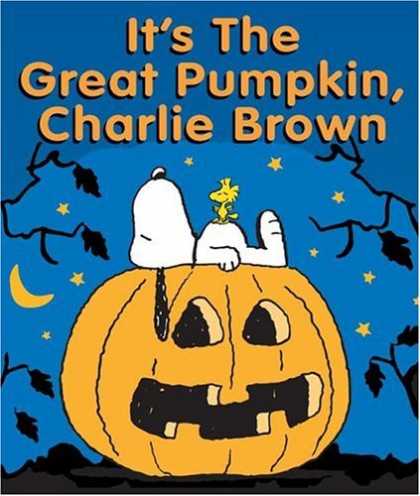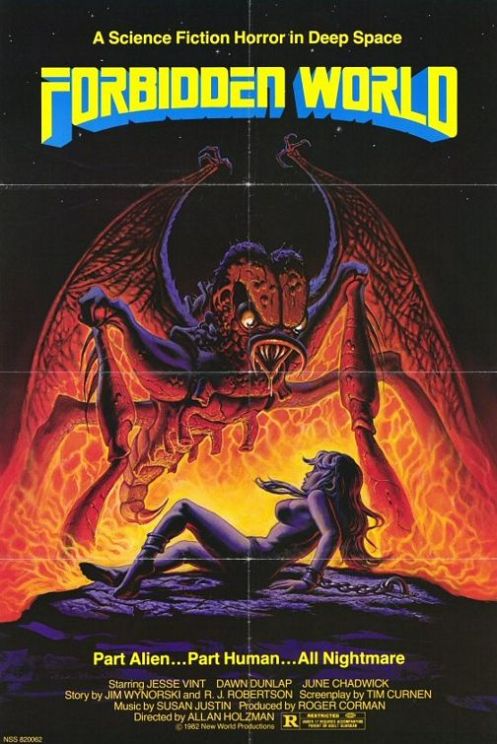(2002) Written and Directed by Don Coscarelli; Based on a short story by Joe Lansdale; Starring: Bruce Campbell, Ossie Davis, Ella Joyce, Reggie Bannister; Available formats: DVD
Rating: ****
Elvis and JFK team up to defend their present-day East Texas rest home from a soul-stealing Egyptian mummy. Huh? Don Coscarelli (Phantasm, Beastmaster) takes this twisted premise, courtesy of writer-extraordinaire Joe Lansdale, and runs with it, creating a movie that defies easy categorization. It’s a horror movie that’s also a comedy, which just happens to be a drama about old age. It’s three, count ‘em, three treats in one! Similar to Trick ‘R Treat (reviewed previously), Bubba Ho-Tep was barely released theatrically, but has gained a cult following on home video. Unlike Trick ‘R Treat, however, it was easy to see what a challenge the film company had trying to market this movie to a jaded 18-to-34 demographic used to youthful protagonists and frenetically paced action scenes. From the beginning, it was clear that this was never going to be blockbuster material.
Bruce Campbell (The Evil Dead films, among many) plays the role of a lifetime as an elderly Elvis Presley, spending his golden years in a dingy East Texas rest home. But Elvis died in 1977, right? Wrong. You see, years ago, Elvis tired of the trappings of success, and decided to switch places with an Elvis impersonator, Richard Haff. Unfortunately, as the result of an unfortunate trailer park accident, his contract with Haff burned up, so there was no way to substantiate his claims. It was Haff who died in Graceland in 1977, leaving the real Elvis Presley to continue on as an impersonator, until he suffered an accident that led to a broken hip, and eventually into a rest home.

The late Ossie Davis (Do The Right Thing) plays John F. Kennedy – yes, you read that right. It turns out, if his story is to be believed, that he did not actually perish in the assassination attempt in Dallas in 1963, and that he isn’t truly African-American, but his skin was “dyed” this color to keep him out of the way. You’re never certain if it’s an act, delusion, or the real thing. Even Elvis seems skeptical, but he goes along with the story anyway. They form an uneasy alliance to fight an Egyptian mummy who has turned up in East Texas, due to another bizarre turn of events.

The idea of an aging Elvis could have been simply played for laughs in the hands of less skilled filmmakers, but Campbell manages to pull off a performance that’s funny and surprisingly touching at times. You feel genuine pathos for his present condition, as he reflects on his changed life and withered body. In true Lansdale fashion, there’s an inordinate amount of emphasis on the current state of his male member, but it’s a potent (pun intended) metaphor for everything else that’s gone wrong in his life. Elvis reflects on his past as someone who once had it all in terms of money and fame, and is now looking back, wondering where it all went, and what the value of it was in the first place.
Coscarelli does a great job of capturing Lansdale’s signature style, employing liberal applications of scatological humor to mask the main characters’ physical and mental pain. The locker room humor is only a façade for deeper issues that lie underneath. While you are laughing at the situations and Elvis’ deadpan narration, this does not serve to denigrate his character, but makes him seem more human. The script navigates a fine balance of illustrating the inherent absurdity of Elvis and JFK’s dilemma while never patronizing them. They function in the story as human beings rather than simple comic foils.
One of the overarching themes of Bubba Ho-Tep is how elderly members of our society are often marginalized and forgotten. Early in the film, we watch as the daughter of a recently deceased rest home resident rummages through her father’s few remaining possessions, discarding anything that doesn’t appear to have any monetary value. The residents of the rest home are little more than feeble children to be tolerated by the listless, dismissive staff -- society’s burden left to die. No one seems to have much use for them anymore, and the residents have little use for life. Elvis and JFK capitalize on their dire circumstances to do something worthwhile one last time.
Unbeknownst to the rest home’s residents and oblivious staff, a recently re-animated Egyptian mummy has begun his nocturnal rampage, feeding on the souls of the weak and elderly. The method by which the mummy obtains and subsequently disposes of these fresh souls can only be described as Lansdalian. Elvis and JFK realize that the mummy will not stop unless someone takes a stand to prevent their fellow seniors from providing an endless supply of souls for the mummy. They covertly devise a plan to defeat the undead threat, and in the face of danger, both protagonists discover a renewed sense of vitality.

As a sort of back-handed compliment, some reviews have emphasized how Bubba Ho-Tep differs from “conventional” horror films, warning those who are looking for quick scares or tons of gore to stay away. I tend to think that most people who seek out this film know what they’re getting into, and if they don’t they might be in for a pleasant surprise. Bubba Ho-Tep is certainly unconventional, but it rewards viewers with a funny, creepy, and surprisingly thoughtful movie that puts a new spin on the whole Elvis Presley/JFK mythos. Don’t expect anything, just watch.
































